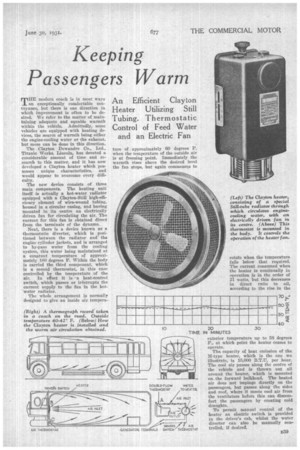Keeping Passengers Warm
Page 57

If you've noticed an error in this article please click here to report it so we can fix it.
T'
4 modern coach is in most ways an exceptionally comfortable conveyance, but there is one direction in which improvement is often to be desired. We refer to the matter of maintaining adequate and equable warmth. within the vehicle. Admittedly, some vehicles are equipped with heating devices, the source of warmth being either the engine-cooling water or the exhaust. but more can be done in this direction. The Clayton Dewandre Co., Ltd., Titanic Works, Lincoln, has devoted a considerable amount of time and research to this matter, and it has now developed a Clayton heater which possesses unique characteristics, and would appear to overcome every difficulty.
The new device consists of three main components. The heating unit itself is actually a hot-water radiator equipped with a Clayton-Still high-efficiency element of wire-wound tubing, housed in a circular casing, and having mounted in its centre an electrically driven fan for circulating the air. The current for this fan is obtained direct from the terminals of the dynamo.
Next, there is a device known as a thermostatic diverter, which is positioned between the radiator and the engine cylinder jackets, and is arranged to by-pass water from the cooling system, this water being maintained at a constant temperature of approximately 180 degrees F. Within the body is carried the third component, which is a second thermostat, in this case controlled by the temperature of the air. In effect it is —a heat-control switch, which passes or interrupts the current supply to the fan in the hotwater radiator.
The whole arrangement is normally designed to give an inside air tempera
rotate when the temperature fella below that required. The current consumed when the heater is continually in operation is in the order of 21 watts, but this decreases in direct ratio to nil, according to the rise in the
exterior temperature up to 58 degrees P., at which point the heater ceases to operate.
The capacity of heat emission of the M-type heater, which is the one we illustrate, is 15,000 B.T.U. per hour. The cool air passes along the centre of the vehicle and is thrown out all around the heater, which is mounted on the forward bulkhead. The heated air does not impinge directly on the passengers, but passes along the sides and roof, where it meets cool air from the ventilators before this can discomfort the passengers by creating cold draughts.
To permit manual control of the heater an electric switch is provided in the driver's cab, whilst the water diverter can also be manually controlled, if desired.




































































































